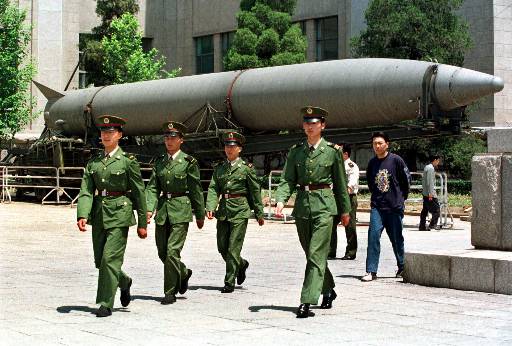China’s military continued its string of strategic missile flight tests on Monday by firing off a third intercontinental ballistic missile in four weeks, according to U.S. officials.
U.S. military sensors detected the latest flight test, which took place in the early morning hours at China’s Wuzhai Missile and Space Test Center, near the town of Wuzhai in northwestern Shanxi province, about 267 miles southwest of Beijing.
The missile was tracked to impact range in the western Chinese desert and was identified as a CSS-4 Mod 2 silo-based ICBM.
It followed the first flight test of a new road-mobile DF-41 multiple-warhead missile on July 24 and the test firing of a new submarine-launched ballistic missile, the JL-2, which is also assessed to be capable of carrying multiple warheads.
It could not be learned if the CSS-4, also called the DF-5A, was assessed to have tested or was configured for multiple warheads or dummy warheads used to fool missile defenses.
U.S. intelligence analysts have said that China is expected to field multiple warhead missiles in the near future. One reason for upgrading from single warhead missiles is China’s concern that U.S. missile defenses in the future could render the single-warhead arsenal impotent.
For example, a recently translated Chinese military report stated that U.S. plans to develop multiple kill vehicle anti-missile interceptors "poses a new threat to defense penetration by ballistic missiles." The report called for increasing missile warhead penetration by using stealth warhead designs and adding warheads or dummy warheads that can confuse missile defense targeting sensors.
The Pentagon did not confirm the three flight tests publicly due to restrictions on discussing intelligence matters, a military spokesman said.
But a senior defense official said the tests aren’t "ringing alarm bells. And it's not at all certain that … the Chinese have exactly perfected all of their missile technologies. That may explain some of the recent testing."
It is not known if the three recent flight tests were successful, but officials said initial indications from sensors were that the missiles did not fail in flight.
A third U.S. official said the tests highlight China’s growing strategic missile arsenal, forces that remain shrouded in secrecy and appear to be moving in the direction of developing a "first strike" attack capability.
China officially has claimed its nuclear forces are mainly "second strike" weapons that would be used to respond to a nuclear attack on China.
China’s communist rulers have said China would not be the first to use nuclear weapons in a conflict.
However, that policy has been questioned by the Pentagon due to statements from Chinese military officials who have discussed the use of nuclear weapons against the United States that were not a response to a U.S. nuclear attack, such as long-range, precision, conventionally armed cruise missile strikes.
By contrast, defense officials have said unusual Air Force delays in conducting a U.S. strategic missile test is a sign that policy officials in the Obama administration may be putting off the missile tests for political, rather than technical, reasons.
A U.S. Minuteman III ICBM was set for earlier this year in California. But the test was delayed three times, ostensibly for technical and range safety concerns.
A defense official said political interference and concerns about Chinese and Russian reactions to the Minuteman test were behind the delays, not just the technical problems.
Spokesmen at the Air Force Global Strike Command, which is in charge of the Minuteman III test, disputed that political factors were behind the test delay and said technical and range safety issues were the reason. The missile test is now set for Nov. 14.
Russia, too, is building a new long-range missile and has not hesitated to carry out tests of both submarine-launched missiles, which have had problems, and a missile that Russian officials have said is designed to penetrate U.S. missile defenses.
The Chinese missile flight tests coincide with the visit to the Pentagon this week by Chinese Lt. Gen. Cai Yingting, deputy chief of the general staff of the Communist Party-controlled People's Liberation Army, and four other generals. It could not be learned if Cai will be questioned on the missile tests during meetings with senior Army and defense leaders.
Analysts said the most recent ICBM test was significant.
"It is likely that a CSS-4 Mod 2 or DF-5 Mod 2 would be the same as the DF-5B, which was said to me in 2010 to be the multiple warhead version of the DF-5," said Richard Fisher, a Chinese military affairs specialist.
"So it is possible that in just one month's time the PLA has tested two new multiple warhead land-based ICBMs and one submarine launched SLBM that could eventually carry multiple warheads," said Fisher, with the International Assessment and Strategy Center.
"At a minimum, the PLA wants to tell us that it will be pointing more nuclear warheads our way and faster."
Hans M. Kristensen, director of the Nuclear Information Project at the private Federation of American Scientists, said the CSS-4 test indicates that the Chinese plan to keep their older, liquid-fueled missiles in the arsenal instead of replacing them with solid-fuel missiles that are more rapidly fired.
Kristensen also said the CSS-4 is a likely candidate for multiple warheads.
"The U.S. intelligence community has stated for more than a decade that China for years has had the capability to develop and deploy multiple warheads, if it decided to do so, and that the CSS-4 would be the most likely carrier," he said.
"One of the factors that has the potential to trigger such a decision would be a U.S. missile defense system that, combined with advanced conventional strike capabilities, could weaken Chinese leaders confidence in the reliability of their retaliatory nuclear force," Kristensen said.
China’s current deployment of mobile, more survivable DF-31 and DF-31A ICBMs "probably makes it less likely that China would see a need to deploy multiple warheads on their missiles, although deployment of penetration aids or decoys might be more likely," he said.
